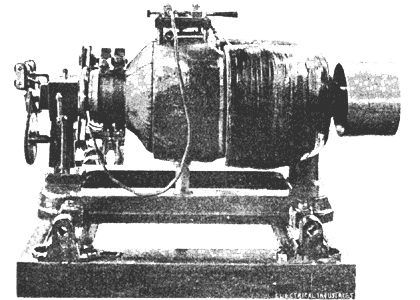[Trade Journal]
Publication: Electrical Industries
Chicago, IL, United States
vol. 5, no. 6, p. 188, col. 1-2
The Bain Arc Dynamo and Regulator.
The accompanying illustration shows one of the latest types of "constant current arc light" dynamo and regulator, the invention of Mr. Foree Bain and manufactured by The Great Western Manufacturing Company, of Chicago. The field is horse shoe shaped, the core being cast in one piece. The armature is of the Gramme type, large in diameter with numerous independent coils. The regulator is said to be very sensitive, very positive in operation and will maintain a constant current independent of the number of lamps in circuit. The brushes or collectors are of carton, so placed as to produce a constant lap on the commutator.
The automatic regulation is performed by the movement of the brushes around the commutator. The motive power for operating the regulating device is secured for a large pulley which is belted to the end of the armature shaft. In the rotation of this large pulley the rachet bar is reciprocated; this rachet bar carries a small rachet, which is held out of engagement with the rachet wheel by means of two elliptical springs on either side of the armature placed between two pair of electro magnets. The rachet wheel is connected by means of a shaft, not shown in the engraving, to a small pinion which engages in gearing cut on the rocker arm which carries the brushes. The directing device, shown under the connecting board, which is mounted on top of the dynamo, consists of a small iron bar suspended immediately over the armature. This director controls two contact devices, shown on the top of the connecting board, the said contact device operating to short circuit both electro magnets when the machine is working under normal conditions and is producing a current at which it has been adjusted.
| |||
| The Bain Arc Dynamo and Regulator. |
The thumb nut, on the right hand side and just below the connecting board, illustrates a means of adjusting the value of the current while the machine is in operation; this thumb nut is connected by means of a bar and a spiral spring to the director bar, and tends to hold it in a position opposite to the position that the bar would assume by an increase of current in the armature. The operation of the device is as follows: When the machine is first started the spring connected to the controller pulls the controller-bar into position approximately parallel with the path of the current circulating in the wires of the armature. When the current in the armature has assumed a given value, which has been predetermined by the tension of the spring, the deflecting bar is deflected from a line parallel with the current in the armature to a line slightly at angle therewith. Before it has been deflected, however, to the position described, the contact above the deflecting bar has been opened by the deflecting bar being out of position it assumes when the machine is operating under normal conditions, an open contact above allows the current to pass through a pair of electro magnets, on the right hand side of the armature, situated between the two pair of electro magnets. The current circulating in this pair of electro magnets attracts the armature towards them and engages the rachet device in the rachet wheel and quickly gigs the rachet wheel, in this case, in clockwise direction, which moves the brushes to a point on the commutator corresponding to the highest potential. If the external resistance is such that the current may be maintained with a lower voltage than the maximum of the dynamo, the current tends to rise above its normal value and the director is deflected to a still greater angle, which causes the contact controlling the electro magnets, on the left-hand side of the electro magnetic armature, to be closed and at the same time, or possible a period later, the contacts controlling the electro magnets, on the left-hand side of the armature, are opened, allowing the current to pass through them and they attract the armature; which causes the double rachet to engage in the rachet wheel in such a way as to cause the rachet wheel to move in an opposite direction from that just described, by the means of which the brushes are moved forward on the commutator to a point where the E. M. F. is just sufficient to maintain a constant current through the resistance contained in the circuit. When the machine is operated through a circuit which is substantially unchanged the brushes remain quiet and the only moving device is the crank wheel and the reciprocating bar, which holds the ratchet, as the rachet is held out of engagement until one or other pair of the electro magnets are energized. The director device may be adjusted at any time while the machine is operating so that it will maintain a constant current at any value desired within a range of 2o per cent of its rated capacity, that is to say, it may be adjusted to deliver a current 20 per cent larger or 20 per cent smaller than its rated capacity. The machine is very substantially constructed; it has self-oiling bearings, is self contained, no outside devices being necessary.

